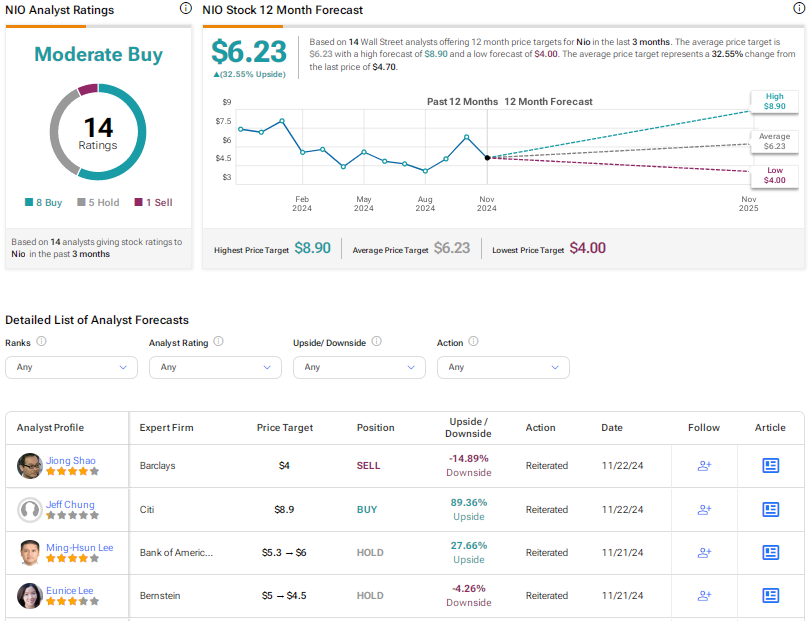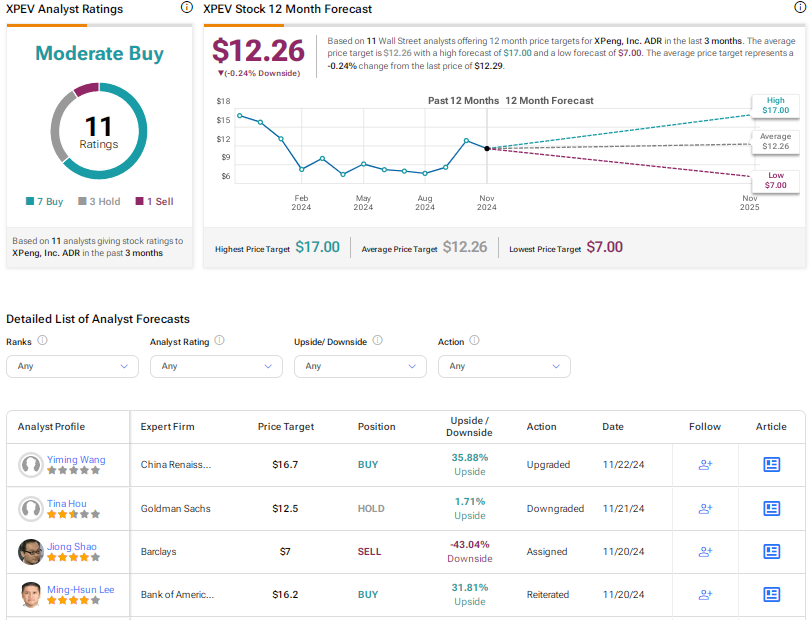I am moderately bullish on both Nio (NIO) and XPeng (XPEV), two relatively new Chinese electric vehicle (EV) companies. However, of the two, XPeng appears to offer the best return potential, as its future growth rates are likely to surpass Nio’s. Both investments are undervalued based on my analysis, but each is likely to face challenges with profitability over the next few years. That said, with profitability expected for both companies in the medium term, I am assigning a Moderate Buy rating to each.
Elevate Your Investing Strategy:
- Take advantage of TipRanks Premium at 50% off! Unlock powerful investing tools, advanced data, and expert analyst insights to help you invest with confidence.
Using TipRanks’ Stock Comparison Tool, let us compare these two Chinese EV makers.

Key Insights from Nio’s Q3 Performance
I’m moderately bullish on NIO stock following its recent Q3 2024 results. The company delivered 61,855 vehicles, achieving a new quarterly record. Additionally, it guided for 72,000 to 75,000 units for Q4 2024. Nio’s ONVO L60 mass-market SUV, a key growth driver, has been ramping up since late Q3, with the company targeting 20,000 units produced per month by March 2025. However, the company’s Q3 revenue did fall by 2.1% year-over-year due to pricing pressure.
In the earnings call, management emphasized long-term growth in Europe, with its global expansion strategy relying heavily on the ONVO and Firefly (a boutique compact car) models to capture mass-market demand. Compared to XPeng, Nio is less aggressive in overseas market expansion but prioritizes brand positioning and infrastructure readiness.
In many respects, XPeng focuses on efficiency, while Nio emphasizes quality. For instance, XPeng’s P7+ AI Hawkeye Visual Advanced Driver Assistance System does not rely on LiDAR or HD maps, which helps reduce costs. In contrast, Nio employs a comprehensive array of sensors, including LiDAR and HD maps. Similarly, in the U.S., Tesla (TSLA) adopts the efficiency-focused model, while Waymo follows a more comprehensive approach, akin to Nio’s strategy.
Meanwhile, Nio’s Q3 revenue grew 7% quarter-over-quarter. While its net loss remained high at RMB 5.1 billion, the company maintained a strong cash position of RMB 42.2 billion. Management is targeting breakeven by 2026. Compared to XPeng, Nio is likely to take longer to reach profitability. Although its revenue base is larger, Nio continues to invest heavily in building its long-term market position, delaying profitability in favor of a stronger future.
One of the core reasons I’m bullish on Nio is its price-to-sales (P/S) ratio of just 1x, significantly lower than historical highs (P/S of 34x in 2020). If the company continues moving toward profitability and sustains strong year-over-year revenue growth of 25% for Fiscal 2024 and 40% for Fiscal 2025, this could become a high-return investment approaching potential profitability in Fiscal 2026 or Fiscal 2027.
What Does Wall Street Say About NIO Stock?
Turning to Wall Street, the average NIO stock price target is $6.23, implying a 32.6% 12-month upside. The Moderate Buy consensus rating for NIO stock is based on eight Buy ratings, five Holds, and one Sell recommendation, reaffirming the company’s potential as both a short- and long-term investment.

XPeng’s Q3 Results Were Even Better
I’m also moderately bullish on XPeng following its Q3 2024 results. The company delivered 46,533 vehicles in the quarter, reflecting a 54% quarter-over-quarter and a 16% year-over-year increase. It has guided for 87,000 to 91,000 units in Q4 2024, with quarter-over-quarter growth momentum nearly double that of Nio. XPeng also outpaced Nio in quarter-over-quarter gross margin growth, driven by cost efficiencies and the launch of its P7+ (an AI-defined executive sedan).
In the earnings call, management highlighted 30,000 firm orders for the P7+ on day one, with 10,000 deliveries expected in December. XPeng is also ramping up production of Mona, an affordable AI-defined compact car priced at RMB 150,000 (~$20,000). Operationally, the company is well-positioned for continued growth, particularly as it targets Level 3 autonomous driving capabilities by Q4 2025.
XPeng’s Q3 revenue was RMB 10.1 billion, up 24.5% quarter-over-quarter. Operating loss narrowed to RMB 1.85 billion, with positive free cash flow guidance for Q4 and beyond. The company holds RMB 35.75 billion in cash. Due to its stronger near-term momentum, XPeng is on track to reach profitability sooner, aided by quick scaling operations and stringent cost controls.
XPeng’s valuation is also highly appealing. The company has a P/S ratio of 2.37x, well below its historical high of 69.4x in 2020. As XPeng is likely to achieve positive free cash flow earlier than Nio, and with consensus revenue growth estimates of 33.5% year-over-year for Fiscal 2024 and 64.5% for Fiscal 2025, I’m slightly more bullish on XPeng in the near term.
What Does Wall Street Say About XPeng?
Wall Street’s average XPEV stock price target is $12.26, indicating that the stock is fully priced at the current levels. The Moderate Buy recommendation on XPeng stock is based on seven Buys, three Holds, and one Sell rating. While short-term downside is possible, I personally find it unlikely to persist into 2026 and 2027, when strong growth and profitability are expected to rerate the company’s fair valuation.

Conclusion: Nio Offers Stability, XPeng Offers Momentum
Both of these investments are Moderate Buys based on my independent analysis. Nio, with its lower valuation and longer-term growth strategy, offers a more stable investment experience. XPeng, on the other hand, provides higher growth momentum and the potential for faster returns, though at the cost of increased volatility. Given XPeng’s stronger near-term outlook, it appears to have the edge in delivering quicker returns, but both companies hold significant promise over the medium to long term.















